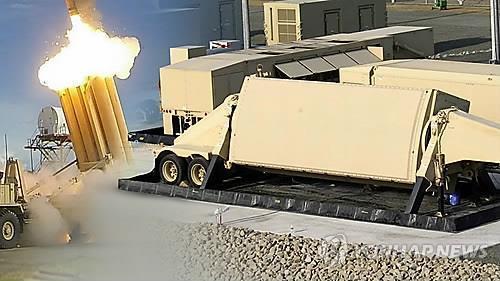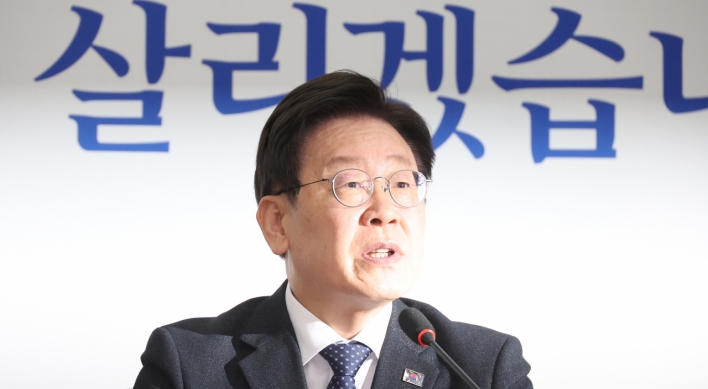Missile defense schedule moved up due to NK threats
By Yoon Min-sikPublished : Oct. 18, 2016 - 16:54
The South Korean government and the ruling party agreed to speed up the completion of its three-legged defense system from the initially planned mid-2020s to early-2020s, in light of the ever-evolving threats from North Korea.
The ruling Saenuri Party also strongly called for the procurement of nuclear-powered submarines here, a matter that the government said it will “carefully consider.”
“Considering the recent security threats like the North’s Sept. 9 nuclear test, we agreed that our defense capacities should be augmented by adding to the previously suggested (defense) budget,” a Defense Ministry official said, debriefing reporters on the government-party meeting held early Tuesday morning.
This means completing the so-called “3K” homegrown defense system against Pyongyang’s nuclear and missile threats earlier than initially planned, the official explained.
The meeting was attended by Defense Minister Han Min-koo, Defense Acquisition Program Administration Minister Chang Myoung-jin, Vice Finance Minister Song Eon-seog and Saenuri lawmakers and discussed the topic of South Korea’s countermeasures against North Korea.
The first part of the “3K” is the Kill Chain, bent on striking the missiles before they are fired. The Korea Air and Missile Defense system is about intercepting the missiles in mid-air, while the Korea Massive Punishment and Retaliation is about striking the North Korea leadership after attack.
The most recently-announced KMPR also includes the possibility of a preemptive attack, upon certain signs of imminent attack by the North.
While the military has been vague on exactly when the systems will be finished, it is believed to be around 2023.
“I would say it would be sped up by around two or three years,” the official said.
The extra budget needed per year is estimated to be around 200-300 billion won ($176 million-$264 million).
The ruling Saenuri Party also strongly called for the procurement of nuclear-powered submarines here, a matter that the government said it will “carefully consider.”
“Considering the recent security threats like the North’s Sept. 9 nuclear test, we agreed that our defense capacities should be augmented by adding to the previously suggested (defense) budget,” a Defense Ministry official said, debriefing reporters on the government-party meeting held early Tuesday morning.
This means completing the so-called “3K” homegrown defense system against Pyongyang’s nuclear and missile threats earlier than initially planned, the official explained.
The meeting was attended by Defense Minister Han Min-koo, Defense Acquisition Program Administration Minister Chang Myoung-jin, Vice Finance Minister Song Eon-seog and Saenuri lawmakers and discussed the topic of South Korea’s countermeasures against North Korea.
The first part of the “3K” is the Kill Chain, bent on striking the missiles before they are fired. The Korea Air and Missile Defense system is about intercepting the missiles in mid-air, while the Korea Massive Punishment and Retaliation is about striking the North Korea leadership after attack.
The most recently-announced KMPR also includes the possibility of a preemptive attack, upon certain signs of imminent attack by the North.
While the military has been vague on exactly when the systems will be finished, it is believed to be around 2023.
“I would say it would be sped up by around two or three years,” the official said.
The extra budget needed per year is estimated to be around 200-300 billion won ($176 million-$264 million).

Augmentations for 2017 include bringing in two anti-ballistic missile radars instead of the previously planned one, increasing the number of Taurus air-to-ground missiles by 90 and deploying navy helicopters ahead of schedule. It would bring the total number of ballistic missile radars to four.
It is yet unclear whether the Saenuri and the government’s plan will receive consent from the opposition, who has not seen eye to eye with them on defense issues such as deployment of the US Terminal High Altitude Area Defense system.
The plans for the Navy helicopters have yet to be cleared at the government-civic defense acquisition program committee, chaired by the defense minister.
Military officials said they have started contacting opposition lawmakers to explain the plan.
They also vowed to mull alternative ways to acquire defense assets that the government is unable to develop in time, such as getting surveillance satellites on lease.
On the much-disputed nuclear submarine, the military has refrained from giving a clear answer.
The technical difficulties notwithstanding, Seoul and Washington have an agreement on peaceful nuclear cooperation. It was designed to ensure that the use of nuclear technology and materials is restricted to civilian use only.
It states that enrichment of up to 20 percent of fissile uranium-235 in South Korea requires US consent.
The prospect of the US agreeing to the idea remains bleak. Washington has been clear on their resolve to retain a non-nuclear South Korea, stressing that the extended deterrence of the US will suffice.
It is widely believed that Roh Moo-hyun administration’s resolve to acquire nuclear-powered submarines in 2003 was scrapped due to pressure from the US.
Proponents of the nuclear submarine here have said that the use of nuclear fuel in a submarine could be interpreted as a “non-military use” because it is not used in a nuclear weapon.
But Seoul’s government has yet to even discuss the matter with the US.
“We did not even open a conversation. We are not likely to talk about it during the Security Consultative Meeting,” a government official said.
The 48th SCM, slated for Thursday, is expected to feature countermeasures on North Korea’s nuclear and missile programs, upcoming transfer of wartime operational control from the US to South Korea, and the ongoing plans for THAAD deployment.
By Yoon Min-sik (minsikyoon@heraldcorp.com)
It is yet unclear whether the Saenuri and the government’s plan will receive consent from the opposition, who has not seen eye to eye with them on defense issues such as deployment of the US Terminal High Altitude Area Defense system.
The plans for the Navy helicopters have yet to be cleared at the government-civic defense acquisition program committee, chaired by the defense minister.
Military officials said they have started contacting opposition lawmakers to explain the plan.
They also vowed to mull alternative ways to acquire defense assets that the government is unable to develop in time, such as getting surveillance satellites on lease.
On the much-disputed nuclear submarine, the military has refrained from giving a clear answer.
The technical difficulties notwithstanding, Seoul and Washington have an agreement on peaceful nuclear cooperation. It was designed to ensure that the use of nuclear technology and materials is restricted to civilian use only.
It states that enrichment of up to 20 percent of fissile uranium-235 in South Korea requires US consent.
The prospect of the US agreeing to the idea remains bleak. Washington has been clear on their resolve to retain a non-nuclear South Korea, stressing that the extended deterrence of the US will suffice.
It is widely believed that Roh Moo-hyun administration’s resolve to acquire nuclear-powered submarines in 2003 was scrapped due to pressure from the US.
Proponents of the nuclear submarine here have said that the use of nuclear fuel in a submarine could be interpreted as a “non-military use” because it is not used in a nuclear weapon.
But Seoul’s government has yet to even discuss the matter with the US.
“We did not even open a conversation. We are not likely to talk about it during the Security Consultative Meeting,” a government official said.
The 48th SCM, slated for Thursday, is expected to feature countermeasures on North Korea’s nuclear and missile programs, upcoming transfer of wartime operational control from the US to South Korea, and the ongoing plans for THAAD deployment.
By Yoon Min-sik (minsikyoon@heraldcorp.com)








![[Hello India] Hyundai Motor vows to boost 'clean mobility' in India](http://res.heraldm.com/phpwas/restmb_idxmake.php?idx=644&simg=/content/image/2024/04/25/20240425050672_0.jpg&u=)










